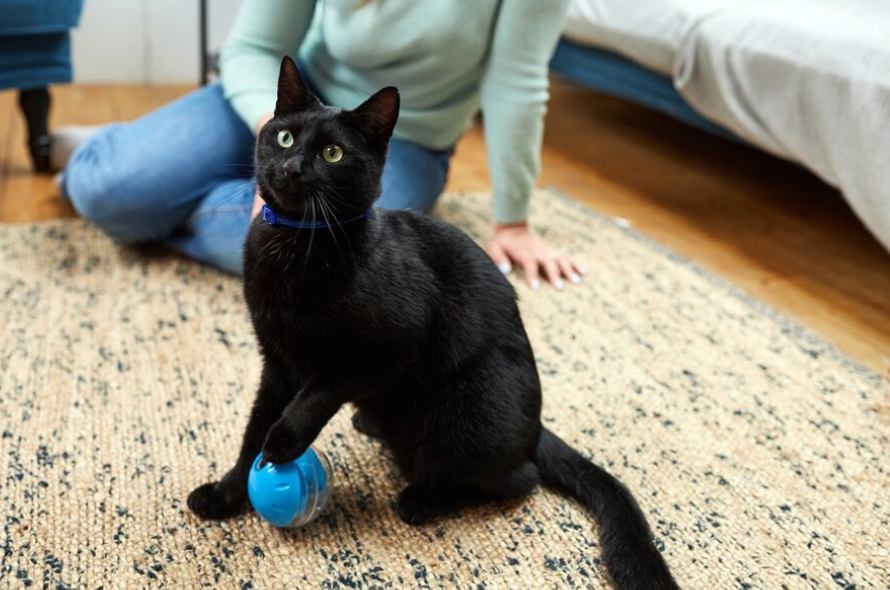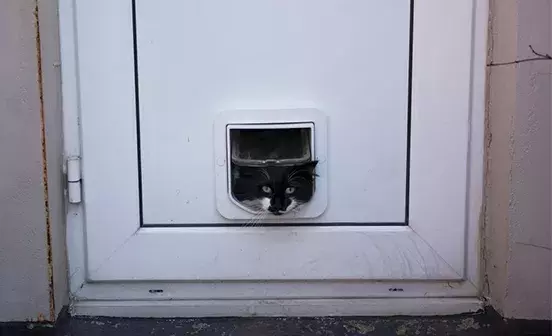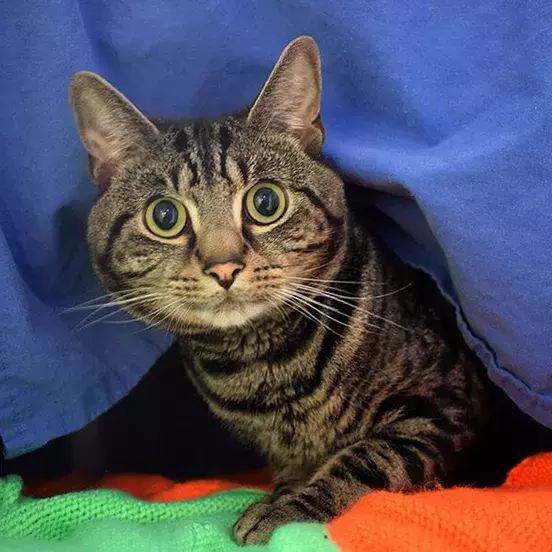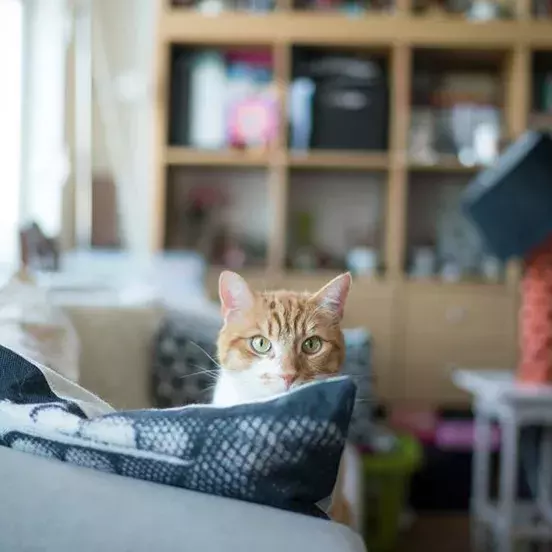Despite what you may think, it is possible to train a cat, and training your cat can be useful in lots of practical ways.

WHAT IS CAT TRAINING?
Basic cat training can help you teach your cat to come to you when called, get them in to a cat carrier as well as feel more comfortable being in one, accept being handled for basic health checks, or to have their claws clipped. If possible, it's best to start cat training from a young age.
When most people think about training animals, they think about teaching them specific things such as performing a ‘stay’, ‘roll over’ or giving a paw. However, any time your cat learns to do more or less of something based on your behaviour, you are in effect training or teaching them. Cat training will also have the added bonus of giving you the opportunity to interact with your cat in a positive, productive way that will stimulate your cat and strengthen your bond.
HOW DO I TRAIN MY CAT?
The best way to train your cat is by using what is known as ‘positive reinforcement’. This means rewarding your cat for performing a desired behaviour. You want your cat to be motivated to learn and feel happy and comfortable doing so. The more the cat feels good about doing something we want them to do, the more likely they are to do it.
When you are training your cat, you will most often be ‘shaping’ their behaviour by rewarding actions that get closer and closer to the end behaviour you want them to perform. The key to effective cat training is to build up gradually. Identify what you would like them to do, then break this down into small steps, and work through these individually at your cat’s pace.
For example, if you are teaching your cat to go into the cat carrier of their own accord, you might first simply give the cat a treat for looking in the direction of the carrier. Next you might reward the cat for walking towards the carrier, then for sniffing it, and so on, until the cat reaches the stage where they enter the carrier voluntarily. You can also lure the cat towards the carrier using treats, and place some inside the carrier to encourage your cat to enter. It is important not to overwhelm them or expect too much too soon.
When cat training, it’s very important that you reward your cat as soon as possible after they perform the behaviour you want from them. If you leave the gap too long, then the cat is unlikely to associate the reward (the treat) with the behaviour you want. You might find it useful to initially create a positive association with a specific word or sound. You can do this by saying something like ‘good’ for example, in an upbeat but calm way, and then immediately giving the cat a treat. The more you do this, the more the cat will associate the word ‘good’ with something nice arriving and give you a few more seconds to get the treat ready to give them.
WHAT CAN I USE TO MOTIVATE MY CAT?
When it comes to motivation, cats are a little different from dogs. In general, cats are less good at (or less interested in!) reading our body language. They probably don’t have a desire to ‘please’ us in the way that dogs do and are much more interested in food rewards than verbal or physical praise. Some cats may see stroking or being given access to a toy as rewarding, however, usually, the best way to motivate your cat is using food. The tastier your cat finds the food, or treat, the more likely they will be to perform the behaviour.
If your cat is very food motivated and becomes overly excited around treats, avoid feeding them treats from your hand. Place the treats on the floor near to you, or throw a little distance away from you, to avoid getting bitten or swiped at. If possible, make sure the treats are hidden in your pocket rather than in an obvious packet to ensure your cat is focused on you rather than the treats. This will also make sure your cat doesn’t become too excited by seeing lots of treats at once!
SHOULD I PUNISH MY CAT?
Cats should not be punished. Punishing your cat won’t help with cat training and may have the opposite effect. Your cat is unlikely to associate the shouting, physical punishment, or removal from the room with what you think they’ve done “wrong”. Instead, your cat is likely to become anxious or frustrated and will begin to associate this feeling with you, or the area where you punished them. By punishing your cat, you may find the problem actually gets worse.
WHEN SHOULD I TRAIN A CAT?
There are lots of situations where cat training using treats and positive reinforcement can help your cat feel less anxious and make things easier all round:
- You can use treats to help your cat get used to something necessary that they may initially find uncomfortable (e.g. having their ears checked or claws clipped). You can ‘distract’ and ‘desensitise’ your cat (i.e. make the unpleasant feeling feel less unpleasant) by feeding them high value food rewards during the handling.
- You can also train your cat to associate things that might previously have made them anxious, with something nice happening. For example, over time, some cats might begin to associate having their ears checked with something tasty appearing. They may even become more receptive to the handling because they are anticipating a reward.
- You can use treats to get your cat to move to a specific location, position, or simply get their attention (i.e. use treats to get your cat to follow you, move in a certain direction, or approach and explore the cat carrier, for example).

HOW TO TRAIN YOUR CAT NOT TO DO SOMETHING
There is usually a good reason why a cat does a certain thing or behaves in a certain way. The best thing to do is try and identify the cause, or why your cat is doing something, and then give them an alternative. For example:
If your cat pesters you for attention while you’re sleeping:
Identify the cause |
Is your cat bored and simply looking for a source of entertainment? Did your cat get enough attention and play time before you went to bed? Do you usually give your cat attention when they pester you at night? |
Provide alternatives |
It may be that your cat would benefit from some puzzle feeders and interactive toys to keep them occupied at night. If you keep your cat indoors at night, it may be that they would be happier being able to have access to the garden. Ensure you have given your cat some ‘quality time’ in the evening before bed. If they do pester you, try to ignore them as much as possible so you’re not “rewarding” this behaviour. |
If your cat scratches on the furniture:
Identify the cause |
Does your cat have suitable places indoors and outdoors to scratch? Could they feel like their territory is under threat from other cats, either inside or outside? How do you respond when your cat scratches where you don’t want them to? |
Provide alternatives |
Make sure you provide your cat with lots of attractive alternatives to where they are currently scratching (We have more advice on this in How to stop my cat scratching the furniture). If you have more than one cat, keep an eye out to make sure they’re getting along. You can also try to deter other neighbourhood cats from coming into your garden and ensure they aren’t coming in your home. A microchip-operated cat flap is often the most effective way to do this. When your cat scratches, don’t pay them any attention, either good or bad. If possible, try restricting your cat’s access to the area where they’re scratching by placing something in front of it. If your cat might be stressed by other cats in the household, take a look at our advice on multi-cat households. |
If your cat pounces on your hands or feet:
Identify the cause |
Maybe you’ve used your hands and feet to play with your cat before? Does your cat have lots of other toys (e.g. moving feather wands and fishing rod toys), and opportunities to run and chase them? Does your cat have access to other things to keep them occupied, like puzzle feeders and access to an enriching outdoor space? |
Provide alternatives |
Make sure you provide your cat with lots of alternative things to entertain them and play with. It sounds simple, but don’t use your hands or feet to play with your cat as this will just reinforce the pouncing behaviour. For more information on ways to provide your cat with a stimulating environment, take a look at our advice on How to make your home cat-friendly and enriching for your cat or How to make your garden or outside space cat-friendly and enriching for your cat. |
If your cat is going to the toilet outside of the litter tray:
Identify the cause |
Is the litter tray in a suitable place where your cat feels comfortable? Is the tray clean? Does the cat have more than one option for where they can go to the toilet? Could another cat be blocking access to the tray? Could your cat be stressed or physically unwell? |
Provide alternatives |
Ensure your cat has at least one tray that is suitable for their age and size, is in a good location and is cleaned and emptied regularly (Take a look at Advice on litter trays for more information). If you have more than one cat in the house, make sure they’re getting on well. (Our advice on multi-cat households will help with this). Your cat may also need a check-up at the vet, or you may benefit from some support from a cat behaviourist (please see How to find a good cat behaviourist). |
If your cat is jumping on surfaces you don’t want them to be on:
Identify the cause |
Is there something on the surface that your cat wants? It might be that you are inadvertently reinforcing this behaviour by paying your cat attention when it happens. Cats generally enjoy being on elevated surfaces – does your cat have other suitable places to jump up to and rest on? |
Provide alternatives |
Make sure your cat has plenty of comfy elevated places that they can reach. Try luring your cat there instead with food or a wand/fishing rod toy. If your cat is somewhere he or she shouldn’t be, calmly and quietly lift them off and place them on the floor without paying them too much attention. |
If your cat behaves aggressively whilst you are stroking them:
Identify the cause |
Make sure you’re paying attention to where you’re touching your cat; are they are actually enjoying it? Could your cat be in any pain or physical discomfort? |
Provide alternatives |
Pay close attention to your cat’s behaviour and body language while you’re stroking them. Make sure the cat has sufficient choice and control during the interaction and that you stop stroking the cat before they are obviously uncomfortable. If you only stop once the cat has had enough, you are actually reinforcing the aggressive behaviour because the cat will learn that this is the best way to get you to stop. If you think your cat could be in pain, you should take them to the vets for a check-up. Take a look at our advice on Cat body language explained for more information. |
Remember, training your cat is a gradual process and can take a long time for the desired behaviours to be learned. It's important to always stay calm and patient and you might be surprised at how many "new tricks" your cat can learn!



